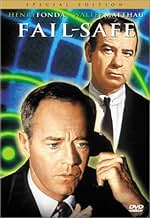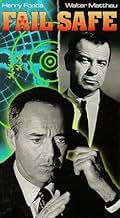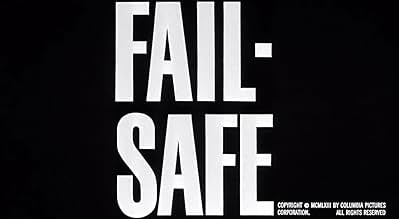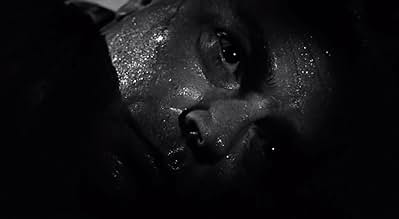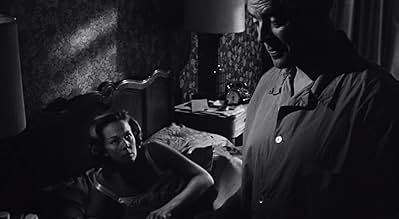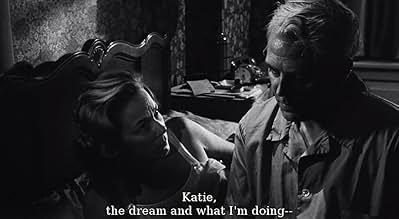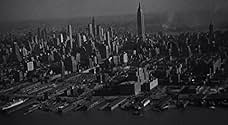PUNTUACIÓN EN IMDb
8,0/10
26 mil
TU PUNTUACIÓN
Una falla técnica envía aviones estadounidenses a Moscú para realizar un ataque nuclear. ¿Se puede evitar una guerra total?Una falla técnica envía aviones estadounidenses a Moscú para realizar un ataque nuclear. ¿Se puede evitar una guerra total?Una falla técnica envía aviones estadounidenses a Moscú para realizar un ataque nuclear. ¿Se puede evitar una guerra total?
- Nominado a 1 premio BAFTA
- 3 nominaciones en total
Dom DeLuise
- Sgt. Collins
- (as Dom DeLouise)
Argumento
¿Sabías que...?
- CuriosidadesThe "computer-generated" image on the control-room screen (including the map of the world, the planes and the explosions) was entirely drawn and animated by hand.
- PifiasThe end credits list General Black's wife as Betty, but in the film he addresses her as Katie and in a radio conversation, the President asks Black, "Are Kathryn and the kids in New York?"
- Citas
US Ambassador: [over the phone] I can hear the sound of explosions from the north east. The sky is very bright. All lit up.
[phone melts and high pitched whining sound starts]
- Créditos adicionales[FINAL CREDIT]: The producers of this film wish to stress that it is the stated position of the Department of Defense and the United States Air Force that a rigidly enforced system of safeguards and controls insure that occurrences such as those depicted in this story cannot happen
- ConexionesFeatured in Henry Fonda: The Man and His Movies (1982)
Reseña destacada
The ultimate moral dilemma confronts the President of the United States when everything goes wrong with the strategic offensive power of a US Air Force bomber squadron, leaving viewers shaken at the end of a superior Cold war drama highlighted by its extraordinary claustrophobia.
Filming of Fail-Safe coincided with filming of Dr. Strangelove, and Stanley Kubrick succeeded in getting his film done first. The earlier publicity for Strangelove hurt Fail-Safe's exposure, and this is doubly disappointing because Fail-Safe is in most ways a superior film, telling its story straight and highlighting superior performances by the entirety of the cast, from Henry Fonda, Frank Overton, Fritz Weaver, and Dan O'Herlihy to a stunningly strong performance by comedian Dom Deluise in a rare dramatic role.
What begins as a routine albiet annoying tour for a visiting Congressman of Strategic Air Command's headquarters in Omaha turns into the ulitmate nightmare. An unidentified aircraft is spotted on a course toward Detroit and airborne bombers are scrambled to fixed points orbiting Soviet Russia until the UFO can be identified. The scramble is routine but this particular one becomes more dramatic as identifying the UFO proves more troublesome than usual, but eventually all is cleared up.
But replacement of a faulty componant in SAC's mainframe briefly flashes the base's plotting board, and activates an attack signal in Bomber Group Six under the command of old-school Colonel Jack Grady (Edward Binns). Attempt to contact Omaha runs into unexpected and mysterious jamming, and the attack signal is verified - Moscow.
It is here that the real nightmare begins, and the President himself must summon Peter Buck (Larry Hagman) down to the underground command shelter in which lies the direct "hotline" oral communication hookup to Soviet Russia's ruling chairman himself. From here the President must coordinate with the Pentagon and SAC HQ to try and stop the bombers, despite endless jamming and the crew's own orders not to answer further contacts.
The actions to stop the bombers drive the drama and bring out the excellence of the cast. Frank Overton is the SAC commanding general whose faith in his systems is shaken by the accident. Fritz Weaver is his XO, driven by shame over his upbringing (shown when he gets into a fight with his alcoholic father before being summoned to SAC HQ) and more likely to crack under the strain. Dan O'Herlihy is a Brigadier General harboring endless doubt about the sagacity of the US strategic arsenal - "We've got to stop war, not limit it," he says, against the better judgement of his peers - who plays a pivotal role in the crisis' outcome.
But even with the excellence of these and others, it is Henry Fonda as the President and Larry Hagman who drive the drama in their hotline conversations with the Soviet chairman; the pivotal angle of these conversations is Peter Buck's whispered comments about the intangibles of the Russian leader's words and expression of them - when the Soviet claims no knowledge of jamming equipment, Buck expresses belief that the Russian is lying - and also his analysis of arguments among the Russian leader's own staff; as the conversations continue on Buck takes on more and more of the role of outright surrogate for the Soviet chairman.
The running battle to stop the bombers leaves the President with a decision that is the only hope, should the bombers succeed, to prevent Russia from a full-scale retaliatory attack that will incinerate the world; the President's decision is of course outrageously implausible in real life but nonetheless works in the context of the film, and leads to a delicious bit of irony at the very end that ties in a bizarre fixation with a matador.
Among the liberties the film takes to tell the story, aside from the hotline telephone (the actual hotline was a teletype transmitter, continuously updgraded over the years), are the types of bombers used and the speed and weapon capability of these craft. Such focus on hardware often hurts dramatic pull, but here it is kept to a minimum and only serves to help move the story along, a nice balance that exemplifies the strength of the story and the performances within.
Filming of Fail-Safe coincided with filming of Dr. Strangelove, and Stanley Kubrick succeeded in getting his film done first. The earlier publicity for Strangelove hurt Fail-Safe's exposure, and this is doubly disappointing because Fail-Safe is in most ways a superior film, telling its story straight and highlighting superior performances by the entirety of the cast, from Henry Fonda, Frank Overton, Fritz Weaver, and Dan O'Herlihy to a stunningly strong performance by comedian Dom Deluise in a rare dramatic role.
What begins as a routine albiet annoying tour for a visiting Congressman of Strategic Air Command's headquarters in Omaha turns into the ulitmate nightmare. An unidentified aircraft is spotted on a course toward Detroit and airborne bombers are scrambled to fixed points orbiting Soviet Russia until the UFO can be identified. The scramble is routine but this particular one becomes more dramatic as identifying the UFO proves more troublesome than usual, but eventually all is cleared up.
But replacement of a faulty componant in SAC's mainframe briefly flashes the base's plotting board, and activates an attack signal in Bomber Group Six under the command of old-school Colonel Jack Grady (Edward Binns). Attempt to contact Omaha runs into unexpected and mysterious jamming, and the attack signal is verified - Moscow.
It is here that the real nightmare begins, and the President himself must summon Peter Buck (Larry Hagman) down to the underground command shelter in which lies the direct "hotline" oral communication hookup to Soviet Russia's ruling chairman himself. From here the President must coordinate with the Pentagon and SAC HQ to try and stop the bombers, despite endless jamming and the crew's own orders not to answer further contacts.
The actions to stop the bombers drive the drama and bring out the excellence of the cast. Frank Overton is the SAC commanding general whose faith in his systems is shaken by the accident. Fritz Weaver is his XO, driven by shame over his upbringing (shown when he gets into a fight with his alcoholic father before being summoned to SAC HQ) and more likely to crack under the strain. Dan O'Herlihy is a Brigadier General harboring endless doubt about the sagacity of the US strategic arsenal - "We've got to stop war, not limit it," he says, against the better judgement of his peers - who plays a pivotal role in the crisis' outcome.
But even with the excellence of these and others, it is Henry Fonda as the President and Larry Hagman who drive the drama in their hotline conversations with the Soviet chairman; the pivotal angle of these conversations is Peter Buck's whispered comments about the intangibles of the Russian leader's words and expression of them - when the Soviet claims no knowledge of jamming equipment, Buck expresses belief that the Russian is lying - and also his analysis of arguments among the Russian leader's own staff; as the conversations continue on Buck takes on more and more of the role of outright surrogate for the Soviet chairman.
The running battle to stop the bombers leaves the President with a decision that is the only hope, should the bombers succeed, to prevent Russia from a full-scale retaliatory attack that will incinerate the world; the President's decision is of course outrageously implausible in real life but nonetheless works in the context of the film, and leads to a delicious bit of irony at the very end that ties in a bizarre fixation with a matador.
Among the liberties the film takes to tell the story, aside from the hotline telephone (the actual hotline was a teletype transmitter, continuously updgraded over the years), are the types of bombers used and the speed and weapon capability of these craft. Such focus on hardware often hurts dramatic pull, but here it is kept to a minimum and only serves to help move the story along, a nice balance that exemplifies the strength of the story and the performances within.
- stp43
- 27 may 2003
- Enlace permanente
Selecciones populares
Inicia sesión para calificar y añadir a tu lista para recibir recomendaciones personalizadas
- How long is Fail Safe?Con tecnología de Alexa
Detalles
- Fecha de lanzamiento
- País de origen
- Idiomas
- Títulos en diferentes países
- Punt límit
- Localizaciones del rodaje
- Westbury, Long Island, Nueva York, Estados Unidos(Roosevelt Field: President's bunker)
- Empresa productora
- Ver más compañías en los créditos en IMDbPro
Taquilla
- Recaudación en Estados Unidos y Canadá
- 3.924.000 US$
- Duración1 hora 52 minutos
- Color
- Relación de aspecto
- 1.85 : 1
Contribuir a esta página
Sugerir un cambio o añadir el contenido que falta

Principal laguna de datos
What is the Japanese language plot outline for Punto límite (1964)?
Responde
![Ver Trailer [OV]](https://m.media-amazon.com/images/M/MV5BZjExYTg4YzctNGIwZC00ZWUwLWFhOWItNTJhYjRiY2UzZjk4XkEyXkFqcGdeQXRyYW5zY29kZS13b3JrZmxvdw@@._V1_QL75_UX500_CR0)
